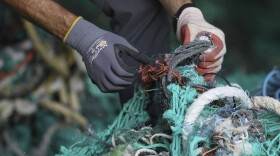The state Department of Health is looking to scale down its contact tracing operation at the end of the year. This comes as local officials seek more federal funds to pay for COVID-19 efforts -- and as infections continue to spread unabated countrywide.
 The health department currently employs about 430 contact tracers. The state’s acting epidemiologist Sarah Kemble, who runs the contact tracing program, thought that may be more than what is needed.
The health department currently employs about 430 contact tracers. The state’s acting epidemiologist Sarah Kemble, who runs the contact tracing program, thought that may be more than what is needed.
“I do anticipate a reduction, we also want to make sure the plan is able to scale if we do have a surge in cases and have additional investigation needs,” she said.
“It's hard to give an exact number because what we actually want is more of a ratio. Like if we have 100 cases per day, how many staff is going to be optimal? If we have 200 cases per day, how many staff is going to be optimal? I actually believe once we get over that 100 case per day mark, the emphasis on the health department reaching each and every case, is of diminishing returns.”
The state currently averages about 75 new COVID-19 cases a day. However the department said, as of early November, contact tracers were able to reach only about 66% of those infected.
The main barriers for contract tracers were the lack of phone numbers and, if they had numbers, people did not answer the phone.
Kemble said DOH would be working with laboratories to ensure that people provide the needed information. She also thinks the public may be feeling fatigued and do not want to isolate or engage with contact tracers about taking necessary steps.
While state federal CARES Act funds expire at the end of the year, DOH does have another $50 million from the federal government that it can spend over a two-year period.
Kemble explained that the money is not meant for short-term uses.
“Those funds are really earmarked for that longer term push and to make sure we build the resiliency within the health department that's going to be needed both to sustain us through this pandemic and through any future pandemic. So many of those funds are going into salary to salaries to positions, those people are being hired,” she said.
“We wouldn't want to spend it all in one place today.”
However, the state’s capacity to contract trace will decline at the end of the year. Members of the Hawaii National Guard, a key part of state contact tracing, will be leaving those posts. Only an extension from President Donald Trump can stop their departure and it’s still not granted.
Regardless, Kemble is confident the program can scale up if another wave of infections washes over the state.
“We are concerned and watching the surging trends nationally. But Hawaii is actually doing pretty well right now,” she said.
“We also have to look at our own case rates as we determine staffing needs, and not purely be reactive to what's happening on a national scale.”
National health experts continue to raise alarms about the soaring numbers heading into the winter months.
The number of hospitalized COVID-19 patients nationwide exceeded 100,000 for the first time since the pandemic began on Wednesday.




